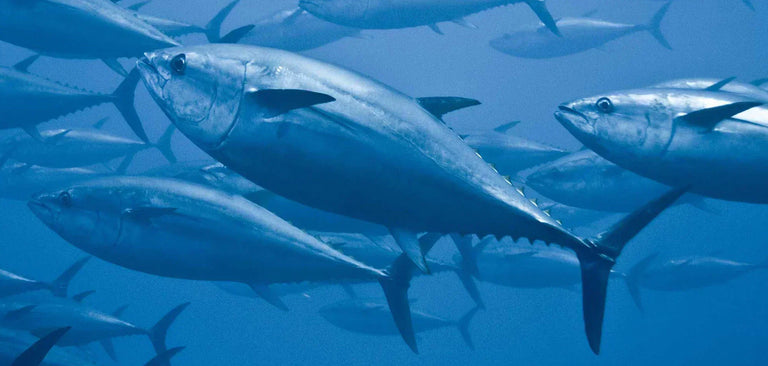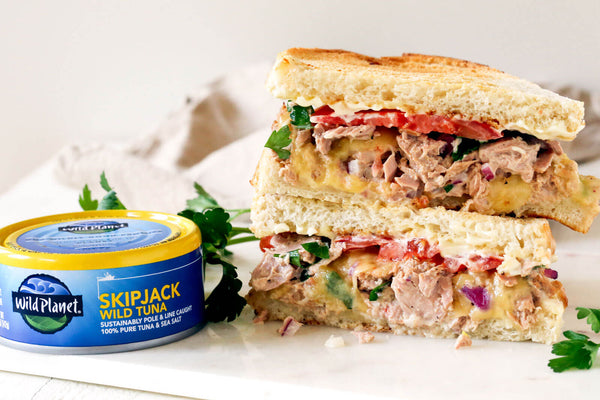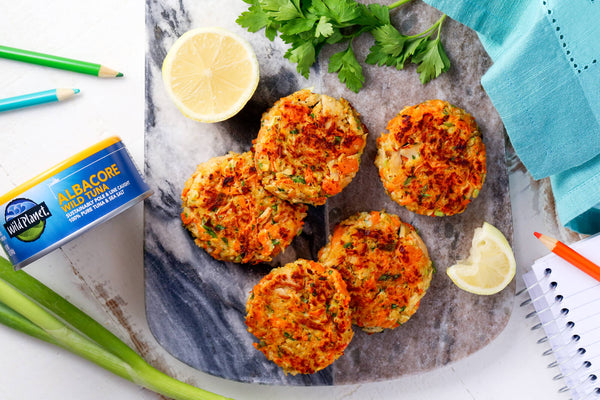There’s only one Wild Planet, and we believe in respecting the resources it gives us. Tuna is a vital resource that is integral for a balanced marine ecosystem and for providing global food security and nutrition. But what should you know about this important fish? In honor of World Tuna Day, we’re sharing eight tuna facts all tuna-lovers should know.

1) What is World Tuna Day?
The UN created World Tuna Day in 2016 to raise awareness of the conservation and management of tuna. It is celebrated annually on May 2nd and shines a spotlight on the vital role that tuna plays in oceanic ecosystems and human livelihoods.
Globally, many countries depend on tuna for economic development, food security, and nutrition. However, wild tuna stocks are declining, and the fish are estimated to be fished at unsustainable levels.
World Tuna Day also emphasizes the importance of sustainable fishing practices. With nearly one-third of tuna stocks reported as being overfished, global efforts to manage and conserve these species are more important than ever.
This unsustainable level of fishing does not allow the tuna species to reproduce in a way that replenishes the ocean. To address these concerns, the UN implemented an international legal framework to the UN Fish Stocks Agreement that has helped to strengthen the Code of Conduct for Sustainable Fishery.
This special day is not just a call to action for policymakers and fisheries but also an opportunity to educate the public about how everyday choices, such as selecting certified sustainable tuna, can help protect this indispensable marine resource for future generations.
2) How many tuna species are there?
There are fifteen species of tuna, but the most common in the food market are Albacore, Bigeye, Yellowfin, and Skipjack. Several other species, including Bluefin and Bonito, are also significant in various contexts.
- Albacore Tuna: Known for its light-colored flesh and mild flavor, albacore tuna is often used in canned tuna and is labeled as “white tuna” in the market.
- Yellowfin Tuna: Yellowfin tuna, also called “ahi,” has a firm texture and a mild flavor, making it versatile for grilling, searing, and raw dishes.
- Skipjack Tuna: Skipjack tuna is the most commonly consumed tuna species, particularly in canned products. Its robust flavor pairs well with many dishes. Skipjack tunas are smaller, opportunistic feeders that play a crucial role in the marine food web.
- Bigeye Tuna: Bigeye tuna is prized for its rich, fatty flesh, making it a popular choice for sushi and sashimi enthusiasts worldwide.
Other, less common tuna species, such as Bluefin and Bonito, also play essential roles in marine ecosystems and global food supplies, showcasing the remarkable diversity and significance of this vital fish.
3) What do tuna eat?
Tuna are critical apex predators in marine ecosystems, and their diet offers insight into their ecological significance. They primarily feed on smaller fish species, such as sardines, anchovies, mackerel, mollusks, lobsters, crawfish, squids, and shellfish.
By consuming these smaller organisms, tuna help maintain the balance of oceanic food webs, ensuring that no single species overpopulates and disrupts the ecosystem. This diet also makes tuna highly nutritious for humans, as they absorb essential proteins and omega-3 fatty acids from the rich marine life they consume.
4) Why are tuna important to the ecosystem?
While tuna are well-known as apex predators, their contributions to marine ecosystems go beyond predation. As pelagic fish, they inhabit the open sea beyond the continental shelf, showcasing significant swimming speed and extensive migration patterns. Tuna play a vital role in supporting primary producers—organisms like phytoplankton and algae that form the foundation of the oceanic food chain.
Bluefin species are notable for their migratory patterns and habitats within the pelagic zone. They travel across oceans and exhibit vertical movements in search of prey, and their spawning congregations are especially vulnerable to commercial fishing.
Through their natural behaviors, such as swimming, feeding, and excreting, tuna facilitate the mixing of water layers, a process crucial for distributing nutrients like nitrogen and phosphorus. These nutrients are essential for the growth and health of primary producers, producing oxygen and forming the basis of marine food webs.
Tuna also contributes to carbon cycling in marine environments. As highly migratory species, they transfer nutrients across vast ocean areas, supporting ecosystems far beyond their immediate surroundings. When tuna die, their biomass sinks and becomes a nutrient source for deep-sea organisms, further enriching marine ecosystems. This nutrient recycling helps maintain a balanced and productive ocean, underscoring the interconnected nature of life in Earth’s waters. Tuna aren’t just consumers but active participants in the ocean’s life-support system, highlighting their importance beyond their role as predators.
5) How is wild tuna fishing done?
Several fishing methods are used to catch tuna in the fishing industry; however, not all methods are created equal.
Respectful methods:
-
Pole & Line: The most sustainable way to catch tuna is pole & line. This method has been used for centuries and allows fishermen to catch migratory, surface-swimming tuna one by one. It eliminates bycatch and, because it’s targeted, allows fishermen to catch the right-sized tuna, allowing juveniles to grow and reproduce.
-
Trolling is another sustainable fishing method that involves towing artificial lures behind a slow-moving boat at the water's surface. Boats might travel anywhere from 4 to 7 mph.5 When fishing for tuna, vessels rig their boats with 10 to 20 barbless fishing lines that appeal to the targeted species: swimming albacore.
Wasteful methods:
-
Purse Seines using FADs: FADs (Fish Aggregating Devices) are radio-beaconed floating devices that attract all fish beyond a targeted species. Small fish, juvenile tunas, and larger predators like sharks, turtles, and dolphins are attracted to the FADs and are often caught along with the tuna and subsequently killed and discarded. Juvenile tuna being caught results in lost food supply, and bycatch mortality disrupts the ocean’s natural balance and threatens local communities’ food security.
-
Long-Line Fishing: This is the most common method used to catch albacore worldwide. Long-line fishing uses long lines that attract a variety of ocean species beyond tuna. Endangered sea turtles, sharks, and other fish also bite the bait creating wasteful bycatch mortality and an unbalanced ocean ecosystem.
6) Are tuna endangered?
Thanks to stricter regulations around fishing quotas, scientists announced last year that several tuna species, including Atlantic bluefin tuna, moved from Endangered to Least Concern, Southern bluefin tuna moved from Critically Endangered to Endangered, and both the albacore and yellowfin tunas moved from Near Threatened to Least Concern. (IUCN Red List)
Despite some recovering stocks globally, certain regions are still being affected by tuna overfishing, and their stocks are still depleted, causing economic and nutritional deprivation for local fishermen's communities. It’s important to create more demand for sustainable fishing methods to ensure the stocks can truly recover.
7) Is my tuna sustainable?
As mentioned previously, there are many ways to catch tuna, some more wasteful than others. GreenPeace urges consumers to opt for more sustainably sourced tuna, such as pole and line-caught tuna. Look for brands that explicitly claim this on their cans.
At Wild Planet, we believe in using one pole, one line, and catching one tuna at a time. This allows us to target our catch, pick the right-sized tuna, and eliminate bycatch. We also only work with small-scale fisheries that employ local community fishermen who uphold our values and share our reverence for ocean life.
8) Should I be worried about mercury?
Mercury is a natural element found in the environment, including the ocean, but human activities such as coal burning and industrial pollution have increased mercury concentrations in marine ecosystems. Larger, older predatory fish like tuna accumulate more mercury over time because of their position in the food chain and the biomagnification process.
According to the National Institutes of Health, consuming high levels of mercury can pose health risks, particularly for pregnant women, nursing mothers, and young children, as it can affect brain development and the nervous system.
At Wild Planet, we prioritize offering mercury-free tuna options by utilizing sustainable fishing practices like the pole & line method. This approach targets smaller, younger tuna species, such as skipjack, which naturally contain lower mercury levels.
Skipjack is naturally lower in mercury than some other species of tuna and is recommended by the FDA as a “best choice” fish for consumption. Even our albacore tuna, caught sustainably, is considered a "good choice." By choosing smaller fish that swim closer to the surface, we ensure a safer, healthier product for our customers.
To further reduce mercury concerns, consumers are encouraged to diversify their seafood choices and follow consumption guidelines provided by organizations such as the FDA and EPA. Responsible fishing and informed consumption can allow tuna's nutritional benefits, such as high-quality protein and omega-3 fatty acids, to be enjoyed without significant health risks from mercury exposure.
Make the Sustainable Choice for a Healthier Ocean and Future
Choosing sustainably sourced tuna isn't just a decision to benefit your own health—it's a powerful way to protect our oceans for generations to come. By supporting methods like pole & line fishing, you’re directly helping to reduce bycatch, preserve marine ecosystems, and empower small-scale fishing communities that depend on the ocean's resources. Every time you prioritize products labeled as sustainably caught, you send a strong message that consumers value ethical and environmentally conscious practices.
At Wild Planet, we believe that every small decision adds up to big change. Together, we can drive demand for healthier oceans while still enjoying the incredible nutrition that tuna provides. Next time you shop, look for certified sustainably caught tuna and celebrate every meal as both a delicious and meaningful choice. Planet-friendly seafood is not just better for you—it's better for the world. Let’s work together to protect our oceans, one can at a time.




